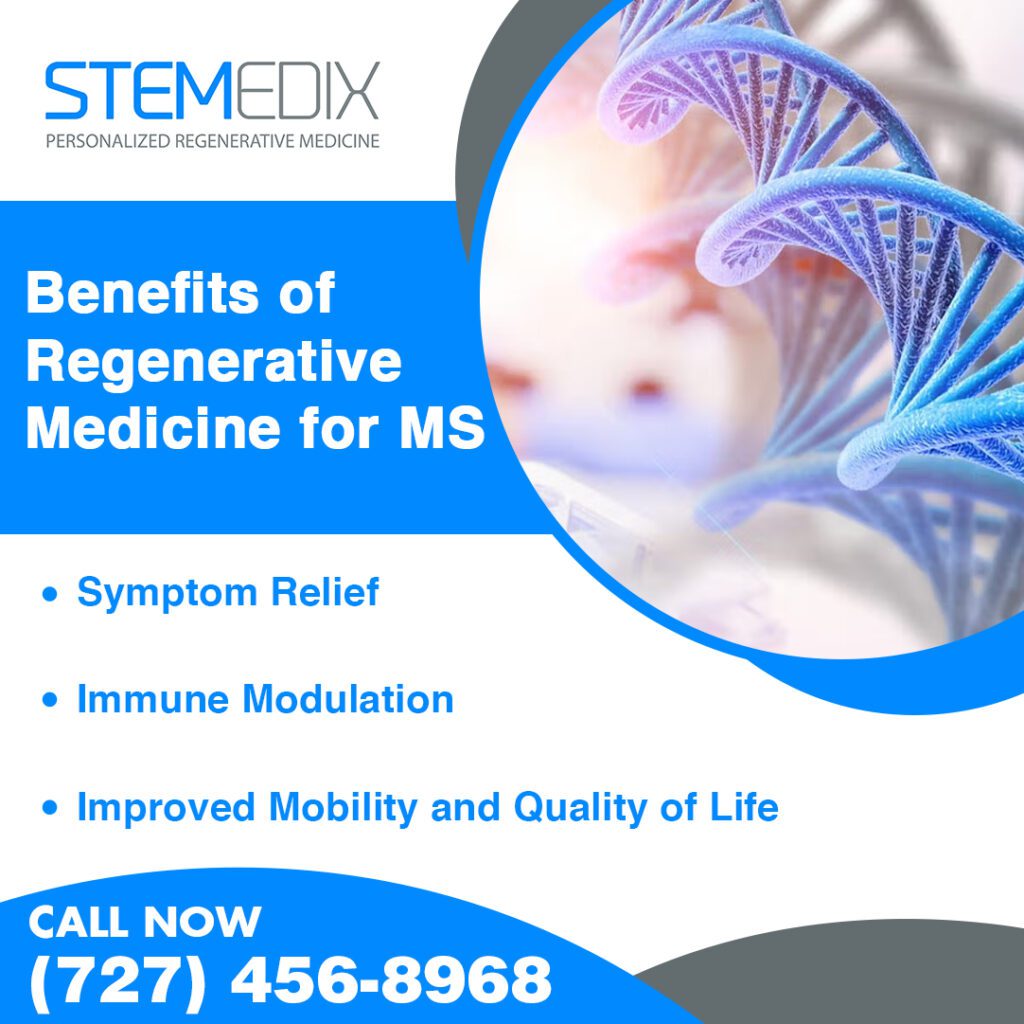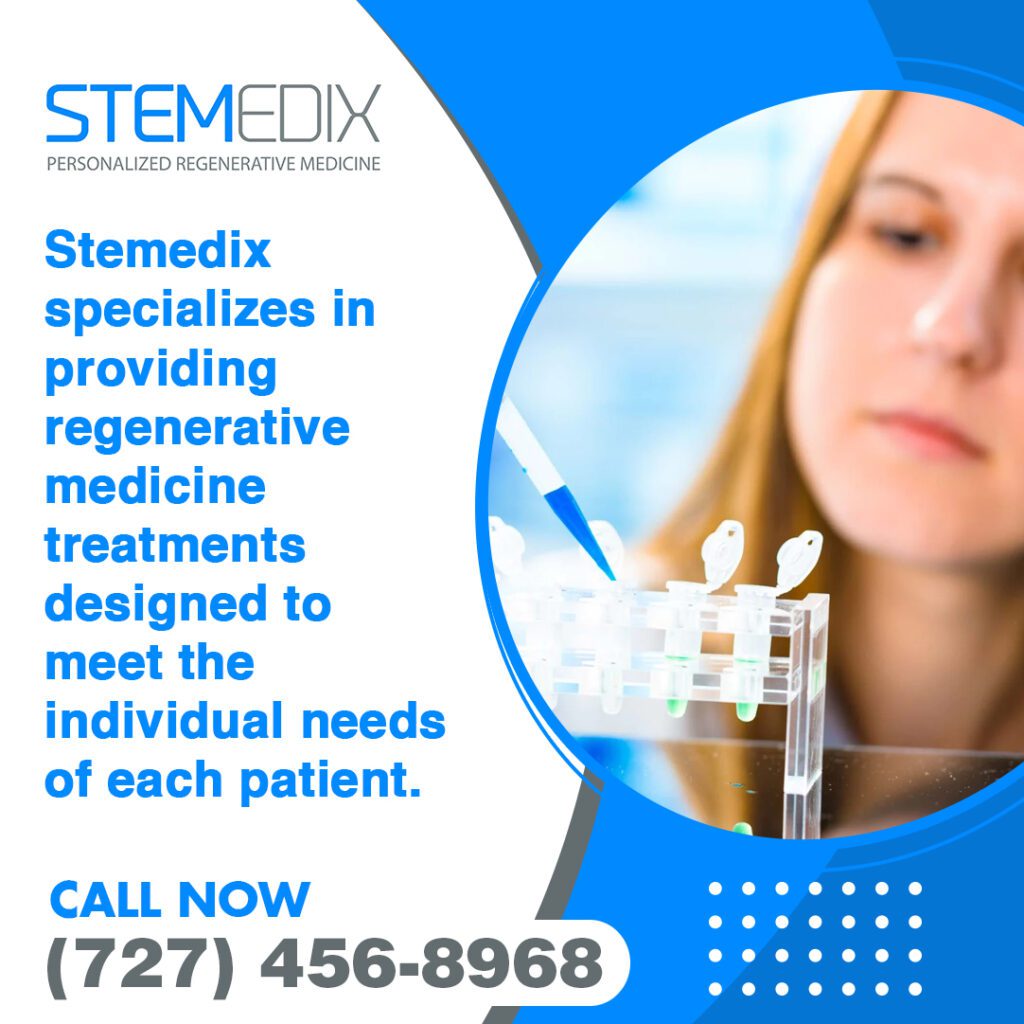
Can Regenerative Medicine Slow the Progression of Multiple Sclerosis?
Multiple Sclerosis (MS) is a long-term condition that affects the central nervous system, leading to symptoms like muscle weakness, difficulty with coordination, and cognitive issues. As people with MS search for effective treatment options, regenerative medicine is becoming an increasingly promising approach. At Stemedix, we provide regenerative medicine treatments aimed at supporting the body’s natural healing abilities and potentially slowing MS progression. These therapies, including stem cell treatments, focus on repairing damaged cells and encouraging tissue regeneration. If you’re looking for regenerative medicine near you to help manage MS, it’s important to understand how these treatments could benefit your health. Regenerative medicine offers hope for individuals living with MS, with the potential to improve daily functioning and reduce the effects of the disease.
Multiple Sclerosis and the Promise of Regenerative Medicine
Multiple Sclerosis (MS) is a chronic condition that disrupts the central nervous system (CNS), which includes the brain, spinal cord, and optic nerves. The disease occurs when the immune system mistakenly attacks myelin, the protective covering around nerve fibers. This leads to inflammation, damage, and impaired nerve signal transmission. Symptoms can range from muscle weakness and vision issues to balance difficulties and cognitive challenges. The severity and progression of MS differ from person to person, making it a complex and often life-altering condition.
Typically diagnosed in young adults between 20 and 40, MS develops due to a combination of genetic and environmental factors. Its impact on daily life can be substantial, often requiring lifelong adjustments to manage symptoms and maintain a good quality of life. While the exact cause of MS remains unknown, research continues to explore innovative ways to address its challenges.
Regenerative medicine is emerging as a promising avenue for MS treatment, focusing on repairing damage caused by the disease. This approach leverages the body’s natural healing processes to restore function and improve health. Therapies such as stem cell treatments, platelet-rich plasma (PRP), and growth factor-based solutions aim to regenerate tissues, reduce inflammation, and support nerve repair. These therapies offer hope for addressing the underlying damage caused by MS.
Among these therapies, stem cell treatments have shown particular potential for MS. Stem cells can transform into various cell types, such as Neural, Schwann, and Oligodendrocytes making them valuable for repairing damaged myelin and reducing inflammation. This ability to promote tissue regeneration targets critical aspects of MS, providing an opportunity to slow disease progression and enhance daily function. Although still under study, regenerative medicine represents a hopeful approach for those seeking innovative solutions to manage MS and improve their quality of life.
At Stemedix, we are dedicated to advancing regenerative medicine treatments for MS. Our personalized care approach guarantees that each patient receives expert advice tailored to their specific needs. If you’re considering regenerative medicine near you, our team is here to guide you through the options and help you take the next step toward a brighter future.

How Regenerative Medicine is Being Studied for MS Treatment
Regenerative medicine is gaining attention as a potential treatment for Multiple Sclerosis (MS). In this chronic autoimmune condition, the immune system mistakenly attacks the protective layer of nerve fibers, known as myelin. This damage leads to inflammation, scar tissue, and disrupted nerve signals, causing a range of symptoms from mobility and balance challenges to cognitive difficulties. Regenerative medicine in MS treatment aims to harness the body’s natural healing abilities to repair damaged tissues, reduce symptoms, and possibly slow or reverse the disease’s progression.
Stem cell therapy, a key area of regenerative medicine research for MS, offers promising possibilities. Stem cells are unique in their ability to become different types of specialized cells, including those that can repair myelin. By encouraging the regeneration of myelin, reducing inflammation, and safeguarding against further damage, stem cells may address critical elements of MS. This therapy may also help regulate the immune system, which plays a central role in the disease, by adjusting the immune response to reduce attacks on the nervous system.
Although regenerative treatments are still being researched, early clinical trials focused on stem cell therapy for MS have shown positive initial outcomes. As research progresses, regenerative medicine holds the potential to provide valuable treatment options that could improve the lives of those living with MS.
Can Stem Cell Therapy Slow MS Progression?
Stem cell therapy shows great potential in helping slow the progression of Multiple Sclerosis (MS). This treatment works by replenishing damaged cells, supporting myelin repair, and boosting the nervous system’s ability to heal itself. In MS, the immune system attacks the protective myelin sheath around nerve fibers, which disrupts communication between the brain and the rest of the body. Stem cell therapy targets this damage by regenerating the protective layer, helping to safeguard nerve fibers and restore lost functionality.
One key benefit of stem cell therapy is that it can address both the symptoms and the underlying damage caused by MS. While many treatments only focus on managing symptoms, stem cell therapy works to repair the myelin and protect the central nervous system from further harm.
Early clinical studies have shown encouraging results. For example, some patients have experienced a reduction in the number of lesions visible on brain scans, improved mobility, and better balance. By regenerating myelin and regulating immune responses, this therapy offers the potential to slow disease progression. Although research is still in the early stages, the results so far are very promising. It’s important for individuals considering stem cell therapy to know that it remains in the clinical trial phase and has not yet become a standard treatment for MS.
Benefits of Regenerative Medicine for MS Patients
Regenerative medicine can offer a range of benefits for individuals with Multiple Sclerosis, addressing not only the symptoms of the disease but also the underlying mechanisms that contribute to its progression. For MS patients, regenerative medicine treatments like stem cell therapy hold promise in providing relief and improving overall well-being.
Alleviating Symptoms: One of the main goals of regenerative medicine for MS patients is to help alleviate symptoms such as muscle weakness, difficulty walking, and problems with coordination and balance. By promoting myelin repair and nerve regeneration, regenerative treatments can restore functionality to the nervous system, improving physical capabilities and overall mobility. This can lead to better balance, reduced spasticity, and increased strength, allowing patients to maintain a higher level of independence.
Immune Modulation: Another key benefit of regenerative medicine is its potential to regulate the immune system. MS is an autoimmune disease in which the immune system mistakenly attacks the protective myelin sheath surrounding nerve fibers. Stem cells, in particular, have shown the potential to reset or modulate the immune system’s response, reducing the frequency and severity of relapses. By calming the immune system’s attack on the nervous system, regenerative treatments may help reduce inflammation and protect healthy tissue from further damage.
Regenerative medicine provides a promising approach to managing Multiple Sclerosis (MS) by targeting both physical and immune health. While more research is still needed to fully understand the long-term impact, early findings from clinical studies indicate that regenerative treatments could improve the quality of life for MS patients.
As studies in regenerative medicine advance, treatments are already available to help slow the progression of MS, alleviate symptoms, and improve overall well-being. With ongoing advancements in stem cell therapy and other regenerative treatments, MS patients now have access to therapies that address both the root causes and symptoms of the disease.
Is Regenerative Medicine a Cure for MS?
Regenerative medicine offers hope for individuals with Multiple Sclerosis (MS), but it’s important to recognize that it is not a cure. Treatments like stem cell therapy have shown promise in managing symptoms and possibly slowing the progression of the disease, but they do not eliminate MS or stop its advancement completely.
The goal of regenerative medicine for MS is to work alongside other treatments to provide relief from symptoms. These therapies focus on repairing damaged tissues, regenerating nerve cells, and promoting healing in the nervous system. By addressing issues like damage to the myelin sheath and impaired nerve communication, regenerative medicine can help improve mobility, functionality, and overall quality of life.
For those considering regenerative medicine, it’s important to have realistic expectations. MS is a complex, progressive disease, and the effectiveness of regenerative treatments can vary based on factors like disease stage, type of MS, and individual health. While these therapies show potential in improving symptom management and slowing disease progression, they are meant to be part of a broader treatment plan. Consulting with a qualified healthcare provider is essential to understanding the potential benefits and limitations of regenerative medicine and whether it aligns with your health goals.
Safety and Risks of Regenerative Medicine for MS
When considering regenerative medicine for Multiple Sclerosis (MS), safety is an important factor. While stem cell therapy and other regenerative treatments have shown potential, it is important to acknowledge that they do come with some risks. Being aware of these risks helps you make an informed choice about whether regenerative treatments are right for you.
A key concern with stem cell therapy is the possibility of complications during the procedure itself, including infection, tissue rejection, and unwanted reactions. In some cases, stem cells may not integrate into the body as expected, which could result in limited therapeutic benefits. Additionally, since regenerative therapies are still under investigation, the long-term safety of these treatments has not been fully determined. Patients may experience side effects like inflammation or immune responses, depending on the type of stem cells or other treatments used.
Being fully informed about the risks and potential side effects is essential when considering regenerative medicine for MS, ensuring that you are prepared for the process and can make the best decision for your health.
It is important to consult with a qualified healthcare provider before considering regenerative medicine treatments. A trusted professional can help evaluate the potential benefits and risks based on your condition and help you choose the most suitable treatment options. They will also make sure that any regenerative therapies are integrated into a well-rounded, evidence-based plan for managing MS.
Although regenerative medicine offers promising potential for MS treatment, it is important to have a clear understanding of its current limitations and possible risks. Thoughtful consideration and expert guidance will support you in making the most informed decision for your health and well-being.

How Stemedix Can Help Patients with MS
At Stemedix, we are committed to providing advanced regenerative medicine treatments designed to help manage the symptoms of Multiple Sclerosis (MS) and slow its progression. We recognize that MS is a complex and challenging condition that requires a thoughtful approach to treatment. Our mission is to offer regenerative therapies that aim to enhance the quality of life for MS patients while providing new possibilities for managing the disease.
Our regenerative medicine options, including stem cell therapy, have shown potential in supporting nerve regeneration and myelin repair, both of which are important in slowing the progression of MS. At Stemedix, we focus on offering treatments that are supported by scientific evidence and customized to meet each patient’s unique needs. We are dedicated to providing therapies that can truly impact your health journey and improve your overall well-being.
Personalized Care Approach
At Stemedix, we take a personalized approach to care, understanding that each person’s journey with Multiple Sclerosis (MS) is different. That’s why we prioritize creating a treatment plan tailored to your unique symptoms, medical history, and personal goals. Our care coordinators are dedicated to working closely with you at every stage, offering guidance, support, and education to help you fully understand the potential benefits and risks of regenerative treatments.
From your initial consultation through to ongoing care after treatment, our goal is to make your experience as smooth and informative as possible. Our care coordinators are always available to address any concerns, assist with scheduling, and provide answers to any questions you may have about regenerative medicine. This guarantees that you feel comfortable and confident in the decisions you make regarding your health.
Determining if Regenerative Medicine is Right for You
If you’re thinking about regenerative medicine treatments for MS, the next step is to schedule a consultation with Stemedix. During this meeting, one of our skilled medical providers will review your specific situation and discuss possible treatment options. This will include a detailed look at your medical history, current symptoms, and the stage of your MS. Our providers will then determine if regenerative medicine treatments, such as stem cell therapy, are appropriate for your needs.
We believe in clear communication and working closely with our patients. We encourage you to ask questions about the treatments, potential outcomes, and the steps involved in the process. At Stemedix, we are committed to making sure you have all the information you need to make confident decisions about your health.
If you and your healthcare provider determine that regenerative medicine is the right option for you, we will collaborate closely to develop a personalized treatment plan and offer continuous support throughout the process. Whether you’re focused on managing symptoms, enhancing mobility, or exploring ways to slow disease progression, we’re here to assist you at every stage.
Stemedix takes a compassionate and individualized approach to treating MS with regenerative medicine near you. With our advanced therapies, tailored care, and dedicated team, we are committed to improving the lives of MS patients and helping you move toward better health.
Exploring Regenerative Medicine for MS Treatment with Stemedix
Regenerative medicine offers an exciting new option for those living with Multiple Sclerosis (MS), giving hope to patients who want to slow the progression of the disease. Stem cell therapy and other regenerative treatments can help repair damage caused by MS, such as nerve degeneration and myelin loss. While regenerative medicine cannot cure MS, it shows great potential to improve symptoms and enhance quality of life.
As research in this area continues to evolve, patients need to stay up to date and consult with trusted healthcare professionals to find the most suitable treatment. Ongoing research will continue to refine these therapies, bringing more benefits to those seeking relief. Patient consultations are key to customizing treatment plans and setting realistic expectations for individual conditions.
If you or someone you care about is considering regenerative medicine treatments for MS, Stemedix, based in Saint Petersburg, FL, is ready to assist. Our team of skilled professionals is dedicated to supporting you throughout the entire process, helping you make informed decisions about your healthcare. To find out more about how regenerative medicine could aid in managing MS, contact us today. Contact Stemedix at (727) 456-8968 or email us at yourjourney@stemedix.com to schedule your consultation and take the next step toward better health.





 St. Petersburg, Florida
St. Petersburg, Florida
